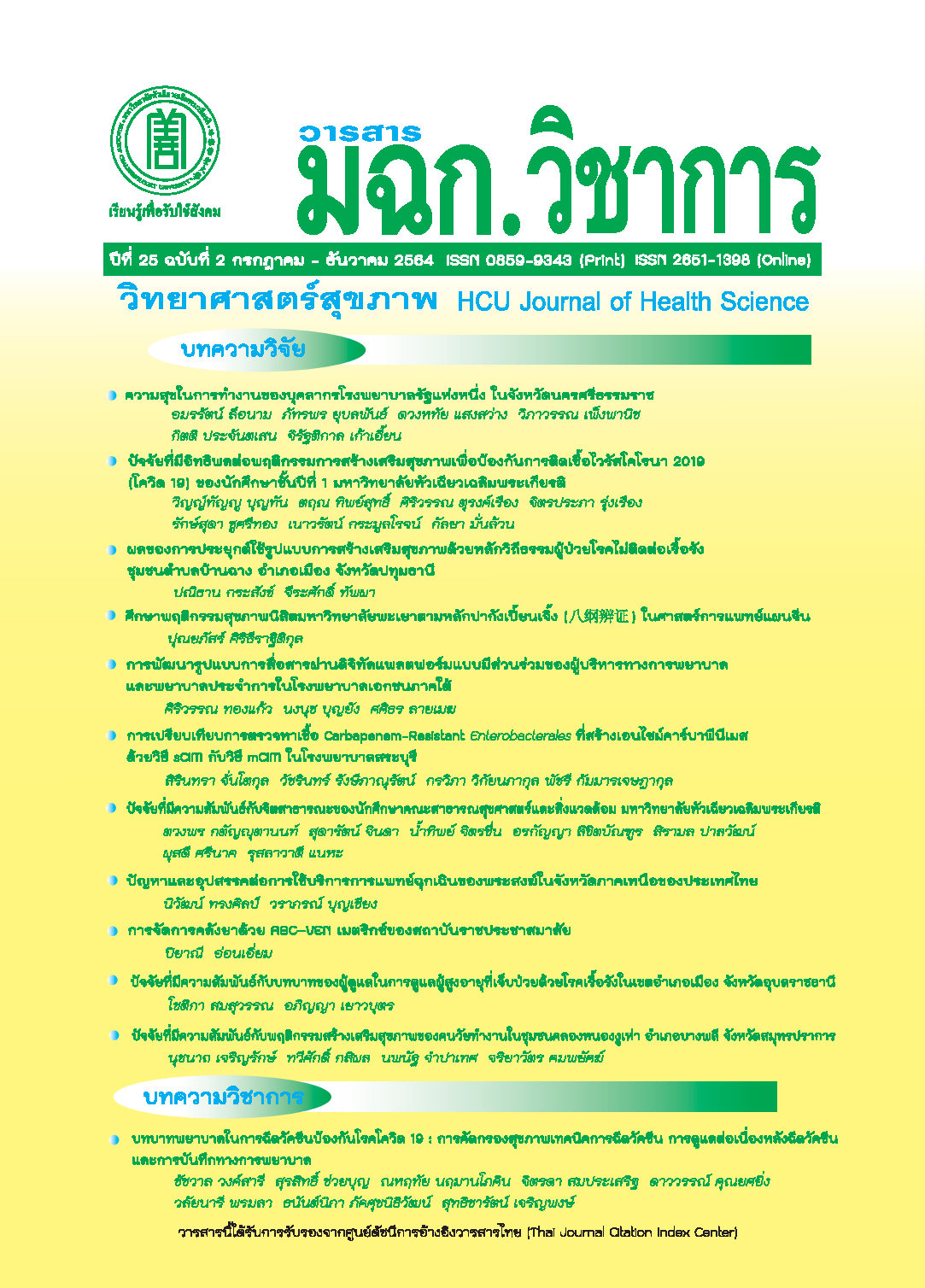Happiness at Work of Personnel Working in a Government Hospital in Nakhon Sri Thammarat Province
Keywords:
Happiness, work of personnel working in a government hospitalAbstract
The aims of this study were to assess the level of happiness at work and analyze the relationship between factors in the organization, quality of life, and the happiness at work of personnel working in support and service departments in a government hospital in Nakhon Sri Thammarat Province. This cross-sectional study was conducted from March to April 2018 among 105 participants. A self-administered questionnaire was used. Descriptive statistics were used to access the level of happiness. The Pearson’s Product-Moment Correlation Coefficient was used to analyze the relationship between happiness at work, factors of organization, and quality of life. The result showed that the majority of participants (68.57%) had a fair level of happiness at work followed by a high (30.48%) ( ±S.D; 3.39±0.54, 95%CI; 3.29 – 3.50), respectively. While the factors of an organization comprised of leadership and management policy were positive correlations with happy heart, happy society and happy relax, respectively. In addition, working environment, workplace relationship, and job description were positive correlations with happy heart, happy society, respectively. All eight aspects of happiness at work were positive correlations with quality of life with the statistically significant level of 0.05. It is suggested that administrators need to work together to strengthen and support to build happiness at work in all aspects, especially happy brain, happy relax, and happy money. Since they were less happy at work than others aspect.
Downloads
References
2 สำนักงานกองทุนสนับสนุนการสร้างเสริมสุขภาพ. คู่มือมาสร้างองค์กรแห่งความสุขกันเถอะ. กรุงเทพมหานคร; 2552.
3 กระทรวงสาธารณสุข. แผนยุทธศาสตร์การพัฒนาคุณธรรมจริยธรรม พ.ศ. 2560-2564. นนทบุรี; 2559.
4 คมกริช สุรเวช. ความสุขในการทำงานของบุคลากร สังกัดสำนักงานสาธารณสุขจังหวัดชุมพร [วิทยานิพนธ์]. เชียงใหม่: มหาวิทยาลัยเชียงใหม่; 2554
5 Chaiprasit, Kemakorn, Orapin Santidhiraku. Happiness at work of employees in small and medium-sized enterprises, Thailand. Procedia-Social and Behavioral Sciences. 2011;25: 189-200.
6 โรงพยาบาลรัฐแห่งหนึ่ง. สถิติการการโอนย้าย ลาออก ของบุคลากร. นครศรีธรรมราช; 2561.
7 เรณู สุขฤกษกิจ. ปัจจัยที่มีผลต่อความพึงพอใจในการปฏิบัติงานของบุคลากรในบริษัทท่าอากาศยานไทยจำกัด [วิทยานิพนธ์]. ปทุมธานี: มหาวิทยาลัยเทคโนโลยีราชมงคลธัญบุรี; 2554.
8 สุวัฒน์ มหัตนิรันดร์กุล, วิระวรรณ ตันติพิวัฒนสกุล, วนิดา พุ่มไพศาลชัย, กรองจิตต์ วงศ์สุวรรณ, ราณี
พรมานะจิรังกุล. เปรียบเทียบตัวชี้วัดคุณภาพชีวิตของ WHO 100 ตัวชี้วัด. เชียงใหม่: โรงพยาบาลสวนปรุง; 2540.
9 นภัส จิตต์ธีรภาพ. ปัจจัยส่วนบุคคล ความสุขในการทำงาน และความผูกพันต่อองค์การของพนักงาน :
กรณีศึกษาโรงงานอุตสากรรมผลิตอาหารแห่งหนึ่ง [วิทยานิพนธ์]. กรุงเทพมหานคร: มหาวิทยาลัยธรรมศาสตร์; 2554.
10 นฤมล แสวงผล. ปัจจัยที่มีผลต่อความสุขในการทำงานของบุคลากร คณะบริหารธุรกิจ มหาวิทยาลัยเทคโนโลยีราชมงคลธัญบุรี [วิทยานิพนธ์]. ปทุมธานี: มหาวิทยาลัยเทคโนโลยีราชมงคลธัญบุรี; 2554.
11 ฌานิกา วงษ์สุรีย์รัตน์. ความสัมพันธ์ระหว่างคุณภาพชีวิตการทำงาน ความสุขในการทำงาน โดยมีความเพลินเป็นตัวแปรกำกับความสัมพันธ์: กรณีศึกษาบริษัทวิศวกรรมก่อสร้างนอกชายฝั่งแห่งหนึ่งในกรุงเทพมหานคร [วิทยานิพนธ์]. กรุงเทพมหานคร: มหาวิทยาลัยธรรมศาสตร์; 2554.
12 Prachuntasen K, Laohasiriwong W and Luenam A. Social capital associated with quality of life among late adults and elderly population in the Northeast of Thailand. F1000Research. 2018, 7:496.
13 Fisher, Cynthia D. Happiness at work. International journal of management reviews. 2010,12(4): 384-412.
14 Olsson, L. E., Gärling, T., Ettema, D., Friman, M., & Fujii, S. Happiness and satisfaction with work commute. Social indicators Research. 2013, 111(1): 255-263.
15 World Health Organization. Ottawa Charter for Health Promotion (1986).The Adelaide
Recommendations on Healthy Public Policy 1988. Geneva Switzerland: World Health
Organization; 1988.
16 Pramitasari, R., Pitaksanurat, S., Phajan, T., Laohasiriwong, W. (2015). Association between ergonomic risk factors and work-re;ated musculoskeletal disorders in beverage factors workers, Indonesia. In proceeding International Seminar and Workshop on Public Health Action" Building Healthy Community". 2015.
17 Schwefel, D. Unemployment, health and health services in German-speaking
countries. Social science & medicine. 1986, 22(4): 409-430.
18 Diener E, Scollon CN, Lucas RE. The evolving concept of subjective well-being: the multifaceted nature of happiness. In: E Diener (ed.) Assessing well-being: the collected works of Ed Diener. New York: Springer. 2009: 67–100.
19 Frey BS, Stutzer A. Happiness and economics. Princeton, N.J.: Princeton University Press;
2002.
20 อรรถพร คงเขียว. ปัจจัยที่มีผลต่อระดับความสุขในการทำงานของพนักงาน: กรณีศึกษา บริษัท ดี.อี.เอ็ม
คอนฟิแดนท์ จำกัด [วิทยานิพนธ์]. ปทุมธานี: มหาวิทยาลัยเทคโนโลยีราชมงคลธัญบุรี; 2554.
Downloads
Published
How to Cite
Issue
Section
License
บทความที่ได้รับการตีพิมพ์เป็นลิขสิทธิ์ของวารสารวิทยาศาสตร์สุขภาพและสุขภาวะ
ข้อความที่ปรากฏในบทความแต่ละเรื่องในวารสารวิชาการเล่มนี้เป็นความคิดเห็นส่วนตัวของผู้เขียนแต่ละท่านไม่เกี่ยวข้องกับมหาวิทยาลัยหัวเฉียวเฉลิมพระเกียรติ และคณาจารย์ท่านอื่นๆในมหาวิทยาลัยฯ แต่อย่างใด ความรับผิดชอบองค์ประกอบทั้งหมดของบทความแต่ละเรื่องเป็นของผู้เขียนแต่ละท่าน หากมีความผิดพลาดใดๆ ผู้เขียนแต่ละท่านจะรับผิดชอบบทความของตนเองแต่ผู้เดียว




